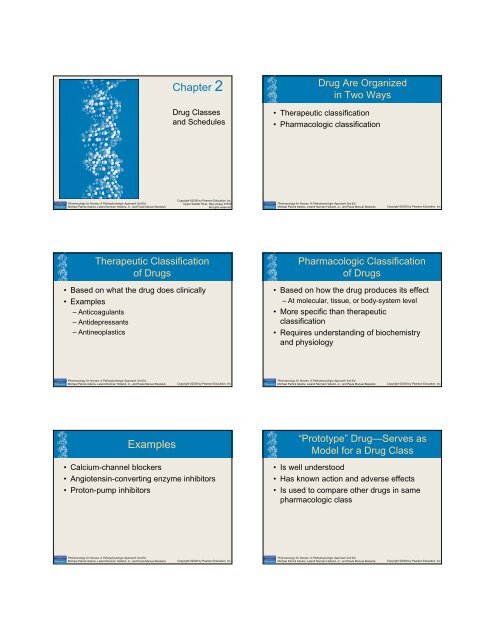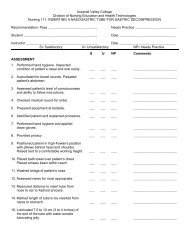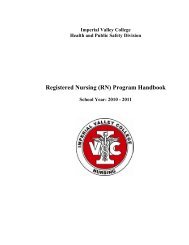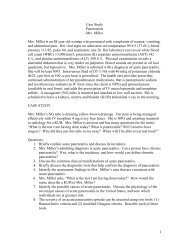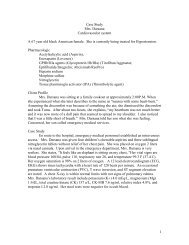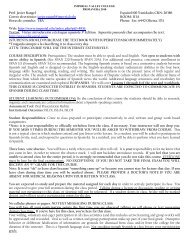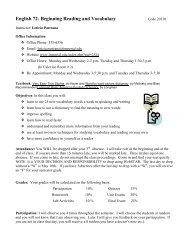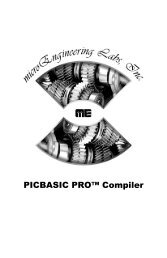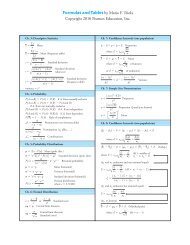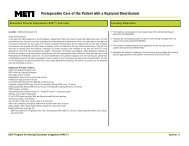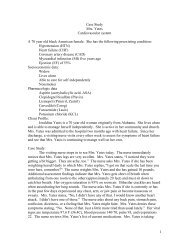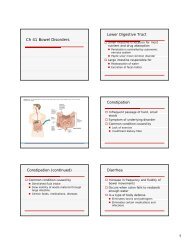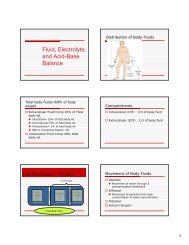Chapter 2 Examples
Chapter 2 Examples
Chapter 2 Examples
Create successful ePaper yourself
Turn your PDF publications into a flip-book with our unique Google optimized e-Paper software.
<strong>Chapter</strong> 2Drug Classesand SchedulesDrug Are Organizedin Two Ways• Therapeutic classification• Pharmacologic classificationCopyright ©2008 by Pearson Education, Inc.Pharmacology for Nurses: A Pathophysiologic Approach 2nd Ed.Michael Patrick Adams, Leland Norman Holland, Jr., and Paula Manuel BostwickUpper Saddle River, New Jersey 07458All rights reserved.Pharmacology for Nurses: A Pathophysiologic Approach 2nd Ed.Michael Patrick Adams, Leland Norman Holland, Jr., and Paula Manuel BostwickCopyright ©2008 by Pearson Education, Inc.Therapeutic Classificationof Drugs• Based on what the drug does clinically• <strong>Examples</strong>– Anticoagulants– Antidepressants– AntineoplasticsPharmacologic Classificationof Drugs• Based on how the drug produces its effect– At molecular, tissue, or body-system level• More specific than therapeuticclassification• Requires understanding of biochemistryand physiologyPharmacology for Nurses: A Pathophysiologic Approach 2nd Ed.Pharmacology for Nurses: A Pathophysiologic Approach 2nd Ed.Michael Patrick Adams, Leland Norman Holland, Jr., and Paula Manuel BostwickCopyright ©2008 by Pearson Education, Inc.Michael Patrick Adams, Leland Norman Holland, Jr., and Paula Manuel BostwickCopyright ©2008 by Pearson Education, Inc.<strong>Examples</strong>• Calcium-channel blockers• Angiotensin-converting enzyme inhibitors• Proton-pump inhibitors“Prototype” Drug—Serves asModel for a Drug Class• Is well understood• Has known action and adverse effects• Is used to compare other drugs in samepharmacologic classPharmacology for Nurses: A Pathophysiologic Approach 2nd Ed.Pharmacology for Nurses: A Pathophysiologic Approach 2nd Ed.Michael Patrick Adams, Leland Norman Holland, Jr., and Paula Manuel BostwickCopyright ©2008 by Pearson Education, Inc.Michael Patrick Adams, Leland Norman Holland, Jr., and Paula Manuel BostwickCopyright ©2008 by Pearson Education, Inc.
Newer drugs in same classMechanism of Action• Newer drugs in same class may havereplaced its use because they:– Are more effective– Have more favorable safety profile– Have longer duration of action• How a drug produces its effect in the bodyPharmacology for Nurses: A Pathophysiologic Approach 2nd Ed.Pharmacology for Nurses: A Pathophysiologic Approach 2nd Ed.Michael Patrick Adams, Leland Norman Holland, Jr., and Paula Manuel BostwickCopyright ©2008 by Pearson Education, Inc.Michael Patrick Adams, Leland Norman Holland, Jr., and Paula Manuel BostwickCopyright ©2008 by Pearson Education, Inc.Most Drugs Have Three NamesDrug Has One Chemical Name• Chemical• Generic• Trade• Assigned using standard nomenclatureestablished by International Union of Pureand Applied Chemistry (IUPAC)• Describes physical and chemicalproperties of drugPharmacology for Nurses: A Pathophysiologic Approach 2nd Ed.Pharmacology for Nurses: A Pathophysiologic Approach 2nd Ed.Michael Patrick Adams, Leland Norman Holland, Jr., and Paula Manuel BostwickCopyright ©2008 by Pearson Education, Inc.Michael Patrick Adams, Leland Norman Holland, Jr., and Paula Manuel BostwickCopyright ©2008 by Pearson Education, Inc.Drug Has One Chemical NameDrug Classification• Complicated, difficult to remember andpronounce– Example: chemical name for diazepam: 7-chloro-1, 3-dihydro-1-methyl-5- phenyl-2H-1,4-benzodiazepin-2-one• Drugs are sometimes classified by aportion of their chemical structure:– Cephalosporins, phenothiazines,benzodiazepinesPharmacology for Nurses: A Pathophysiologic Approach 2nd Ed.Pharmacology for Nurses: A Pathophysiologic Approach 2nd Ed.Michael Patrick Adams, Leland Norman Holland, Jr., and Paula Manuel BostwickCopyright ©2008 by Pearson Education, Inc.Michael Patrick Adams, Leland Norman Holland, Jr., and Paula Manuel BostwickCopyright ©2008 by Pearson Education, Inc.
A Drug Has One Generic NameA Drug Has One Generic Name• Assigned by the US Adopted NameCouncil• Less complicated and easier to remember• Describes active ingredients• Used by many organizations– Food and Drug Administration (FDA)– US Pharmacopoeia– World Health Organization• Written in lower case• Example: diazepamPharmacology for Nurses: A Pathophysiologic Approach 2nd Ed.Pharmacology for Nurses: A Pathophysiologic Approach 2nd Ed.Michael Patrick Adams, Leland Norman Holland, Jr., and Paula Manuel BostwickCopyright ©2008 by Pearson Education, Inc.Michael Patrick Adams, Leland Norman Holland, Jr., and Paula Manuel BostwickCopyright ©2008 by Pearson Education, Inc.A Drug Has Several Trade NamesA Drug Has One Generic Name• Assigned by company marketing the drug• Short, easy to remember• Also called proprietary, product, or brand name• Drug developer has exclusive rights to nameand market a new drug for 17 years in US.• Trade name is capitalized• Example: trade name for diazepam is Valium• Assigned by the US Adopted NameCouncil• Less complicated and easier to rememberPharmacology for Nurses: A Pathophysiologic Approach 2nd Ed.Pharmacology for Nurses: A Pathophysiologic Approach 2nd Ed.Michael Patrick Adams, Leland Norman Holland, Jr., and Paula Manuel BostwickCopyright ©2008 by Pearson Education, Inc.Michael Patrick Adams, Leland Norman Holland, Jr., and Paula Manuel BostwickCopyright ©2008 by Pearson Education, Inc.Communication Enhanced• Health-care providers and other healthorganizations use generic names• Written in lower caseSome States Have a NegativeFormulary List• List of trade-name drugs that pharmacists maynot dispense as generic-drug substitutes• Claim there are differences in bioavailabilitybetween generic and trade-name drugs• Pharmaceutical Companies and Some Health-Care Practitioners Support List• Claim differences could adversely affect patientoutcomesPharmacology for Nurses: A Pathophysiologic Approach 2nd Ed.Pharmacology for Nurses: A Pathophysiologic Approach 2nd Ed.Michael Patrick Adams, Leland Norman Holland, Jr., and Paula Manuel BostwickCopyright ©2008 by Pearson Education, Inc.Michael Patrick Adams, Leland Norman Holland, Jr., and Paula Manuel BostwickCopyright ©2008 by Pearson Education, Inc.
Controlled SubstancesAre Drugs That• Are frequently abused• Have a high potential for addiction ordependence– Physical dependence– Psychological dependence• Have restricted use• Are placed into one of five schedulesNot All Drugs with Abuse PotentialAre Regulated• Tobacco, alcohol, and caffeinePharmacology for Nurses: A Pathophysiologic Approach 2nd Ed.Pharmacology for Nurses: A Pathophysiologic Approach 2nd Ed.Michael Patrick Adams, Leland Norman Holland, Jr., and Paula Manuel BostwickCopyright ©2008 by Pearson Education, Inc.Michael Patrick Adams, Leland Norman Holland, Jr., and Paula Manuel BostwickCopyright ©2008 by Pearson Education, Inc.Controlled SubstanceAct of 1970• Also known as Comprehensive DrugAbuse Prevention and Control Act• Restricts use of drugs with potential forabuse• Restricted drugs placed into fiveschedules• Hospitals and pharmacies must maintaincomplete records of scheduled drugsSchedule II DrugsHave More Restrictions• Need special order form to obtain• Orders must be written• Orders must be signed by health-careprovider• Telephone orders to pharmacies notpermitted• No refills permitted• Client must see health-care provider firstPharmacology for Nurses: A Pathophysiologic Approach 2nd Ed.Pharmacology for Nurses: A Pathophysiologic Approach 2nd Ed.Michael Patrick Adams, Leland Norman Holland, Jr., and Paula Manuel BostwickCopyright ©2008 by Pearson Education, Inc.Michael Patrick Adams, Leland Norman Holland, Jr., and Paula Manuel BostwickCopyright ©2008 by Pearson Education, Inc.Controlled Substances• Anyone Convicted of UnlawfulManufacturing, Distributing, andDispensing of Controlled SubstancesFaces Severe PenaltiesDrug Enforcement Administration (DEA)Regulates Controlled Substance Act• Hospitals and pharmacies must registerwith DEA– Must use assigned registration number topurchase scheduled drugsPharmacology for Nurses: A Pathophysiologic Approach 2nd Ed.Pharmacology for Nurses: A Pathophysiologic Approach 2nd Ed.Michael Patrick Adams, Leland Norman Holland, Jr., and Paula Manuel BostwickCopyright ©2008 by Pearson Education, Inc.Michael Patrick Adams, Leland Norman Holland, Jr., and Paula Manuel BostwickCopyright ©2008 by Pearson Education, Inc.
Schedule I Drugs<strong>Examples</strong> of Schedule I Drugs• Highest abuse potential• High physical and psychologicaldependence• Limited or no therapeutic use• Heroin•LSD• MethaqualonePharmacology for Nurses: A Pathophysiologic Approach 2nd Ed.Pharmacology for Nurses: A Pathophysiologic Approach 2nd Ed.Michael Patrick Adams, Leland Norman Holland, Jr., and Paula Manuel BostwickCopyright ©2008 by Pearson Education, Inc.Michael Patrick Adams, Leland Norman Holland, Jr., and Paula Manuel BostwickCopyright ©2008 by Pearson Education, Inc.Schedule II Drugs• High abuse potential• High physical and psychologicaldependence• Therapeutic use with prescription• Some drugs no longer used<strong>Examples</strong> of Schedule IIDrugs• Morphine•PCP• Cocaine• Methadone• MethamphetaminePharmacology for Nurses: A Pathophysiologic Approach 2nd Ed.Pharmacology for Nurses: A Pathophysiologic Approach 2nd Ed.Michael Patrick Adams, Leland Norman Holland, Jr., and Paula Manuel BostwickCopyright ©2008 by Pearson Education, Inc.Michael Patrick Adams, Leland Norman Holland, Jr., and Paula Manuel BostwickCopyright ©2008 by Pearson Education, Inc.Schedule III Drugs• Moderate abuse potential• Moderate physical dependence• High psychological dependence• Therapeutic use with prescription<strong>Examples</strong> of Schedule IIIDrugs• Anabolic steroids• Codeine with aspirin or Tylenol• Hydrocodone with aspirin or Tylenol• Some barbituratesPharmacology for Nurses: A Pathophysiologic Approach 2nd Ed.Pharmacology for Nurses: A Pathophysiologic Approach 2nd Ed.Michael Patrick Adams, Leland Norman Holland, Jr., and Paula Manuel BostwickCopyright ©2008 by Pearson Education, Inc.Michael Patrick Adams, Leland Norman Holland, Jr., and Paula Manuel BostwickCopyright ©2008 by Pearson Education, Inc.
Schedule IV Drugs<strong>Examples</strong> of Schedule IV Drugs• Lower abuse potential• Lower physical and psychologicaldependence• Therapeutic use with prescription• Dextropropoxyphene• Pentazocine• Meprobamate• Diazepam• AlprazolamPharmacology for Nurses: A Pathophysiologic Approach 2nd Ed.Pharmacology for Nurses: A Pathophysiologic Approach 2nd Ed.Michael Patrick Adams, Leland Norman Holland, Jr., and Paula Manuel BostwickCopyright ©2008 by Pearson Education, Inc.Michael Patrick Adams, Leland Norman Holland, Jr., and Paula Manuel BostwickCopyright ©2008 by Pearson Education, Inc.Schedule V Drugs• Lowest abuse potential• Lowest physical and psychologicaldependence• Therapeutic use without prescription• <strong>Examples</strong>– OTC cough medicines with codeinePart III, Schedule G, of CanadianFood and Drugs Act• Controlled substances only dispensed forspecific conditions and diseases• Drugs must be labeled with letter “C” onoutside of container• <strong>Examples</strong>– Amphetamines– Barbiturates– Methaqualone– Anabolic steroidsPharmacology for Nurses: A Pathophysiologic Approach 2nd Ed.Pharmacology for Nurses: A Pathophysiologic Approach 2nd Ed.Michael Patrick Adams, Leland Norman Holland, Jr., and Paula Manuel BostwickCopyright ©2008 by Pearson Education, Inc.Michael Patrick Adams, Leland Norman Holland, Jr., and Paula Manuel BostwickCopyright ©2008 by Pearson Education, Inc.Part IV, Schedule H, of CanadianFood and Drugs Act• Restricted drugs not intended for human use– Drugs used in chemical or analyticalprocedure– Medical, laboratory industrial, educational, orresearch purposes• Restricted drugs, such as–LSD–MDMA– DOM (street name, STP)Schedule F Drugs, Canadian NarcoticControl Act and Amended Schedules• Require prescription• Include– Methylphenidate (Ritalin)– Diazepam (Valium)– Chlordiaepoxide (Librium)• Narcotic drugs must be labeled with theletter N on the outside of the containerPharmacology for Nurses: A Pathophysiologic Approach 2nd Ed.Pharmacology for Nurses: A Pathophysiologic Approach 2nd Ed.Michael Patrick Adams, Leland Norman Holland, Jr., and Paula Manuel BostwickCopyright ©2008 by Pearson Education, Inc.Michael Patrick Adams, Leland Norman Holland, Jr., and Paula Manuel BostwickCopyright ©2008 by Pearson Education, Inc.


